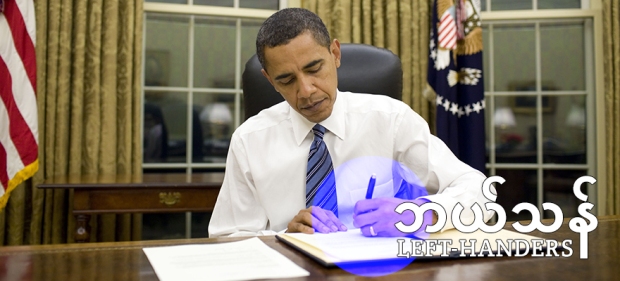I was born with a left hand dominance. To this day, it’s simply instinct for me to reach for things, to brush my teeth, and to use utensils with my left hand. However, I write with my right. Why?
The reason: my parents made a conscious decision to teach me to write with my right hand, from the time they noticed my left hand dominance. I began learning how to write around the age of 3, before I entered kindergarten. According to my mom, I picked up learning how to write right hand very quickly, because I was a blank slate at the time, not having learned to write with my left yet. Perhaps because they began very early, I never experienced academic challenges in school, and my penmanship didn’t suffer. Their reasoning was that left handers faced challenges in schooling that right handers do not, from the orientation of school desks to use of notebooks and scissors, and anything they could do to maximize my potential in a right-handed world, they would.

Obama is one of many left handed American presidents, among them, Bush I and Clinton.
I wonder if there was a cultural element to their thinking–the negative association with lefthandedness. I hadn’t thought anything of this, until I recently discovered one of my uncles is also a left hander, except for the purposes of writing. My grandmother had rigorously trained him to write with his right hand because that “was normal.” Apparently children who wrote with their left hand were actively discouraged from doing so (and converted, whether by teachers or by parents), because it went against the grain, so to speak. Looking back, being seen eating with my left hand had drawn a lot of comments from other Burmese, so many, in fact, that I had come up with an explanation that I wrote with my right hand.
So what is the root of the Burmese bias against left handers? CultureShock! Myanmar, a guide to Burmese etiquette, by Saw Myat Yin, writes:
“In earlier times, lefthandedness was discouraged and “southpaws” were forced to use the right hand for eating and writing. The left hand is only used for cleaning the backside after a visit to the toilet, so it is not used to pass objects to others, especially to elders, honoured guests or monks and nuns. Nowadays, lefthanded children o not have such a hard time…”
So it boils down to cleanliness? Neighboring Thais also believe that the left hand is unclean, and for this reason, use the right hand to pass items. And other Asian countries encourage or force righthandedness because of cultural reasons. Yet mankind has had a consistent distribution of left-handed people–about 10% of the world’s population are left-handed, in spite of clear cultural preferences for righthandedness.
However, converting lefthandness can have a detrimental impact that may manifest itself in other ways. King George VI’s lifelong stuttering problem was likely related to the fact that he was forced to write with his right hand, something that was glossed over in the The King’s Speech. Recent studies have shown that writing with the left or right hand activates different parts of the brain, and converting handedness in fact, increases sensory activity in the right hemisphere (right handers activate the left hemisphere, left handers the right)’s higher order sensorimotor areas, instead of rewiring it, as well as other changes to the brain.
All this makes me wonder whether forced conversion of handedness is still practiced by Burmese families. Maybe my experience isn’t unusual after all, for someone to be converted in the 1990s. Or maybe there’s a more complex explanation for why the Burmese prefer righthandedness. Unlike in many languages, “left” (ဘယ်, be) doesn’t mean anything sinister in Burmese. In fact, one could argue that the Burmese word for “right” (ညာ, nya) is inherently sinister: is pronounced and spelled the same as the Burmese word for “lie” (as in လိမ်ညာ, lein nya).
Perhaps this issue is becoming a moot point. After all, more and more writing is done electronically, which requires the use of both hands. Just something to chew on.

I too write and use fine instruments such as tweezers and scissors with my right hand but large implements always with the left. My brother’s the same. You are probably reading too much into the spelling of nya. The alternative nga ya-yit yaycha is only seen in kyaw nya (advertise) which is arguably closer to a lie. You must also be aware of the formal use let ya for right (often abbreviated to ya in signage) and let wè or abbrev. wè for left.